Main Body
Common Digestive Problems
Before moving to metabolism, we are going learn about some common digestive problems.
Sections:
5.1 Peptic Ulcers
5.2 Gallstones
5.3 Irritable Bowel Syndrome
5.4 Inflammatory Bowel Disease
5.5 Celiac Disease
5.6 Diverticulosis & Diverticulitis
5.7 Hemorrhoids
5.1 Peptic Ulcers
When the mucus layer of the stomach or duodenum becomes too thin, acid can erode the cells lining these tissues. This results in a lesion known as a peptic ulcer, as shown below.
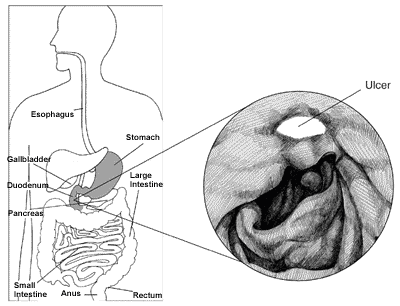
The first video says that goblet cells secrete mucus in the stomach. This is not correct; they secrete mucus in the intestine. It should be neck cells in the stomach. The second link shows what two ulcers actually look like in the stomach.
| Web Links |
10% of Americans will develop an ulcer in their lifetime. Despite common beliefs, these ulcers are not caused by stress or spicy foods. Most ulcers are believed to be caused by the acid-resistant bacteria, Helicobacter pylori. 30-40% of Americans are infected with this bacteria. Helicobacter pylori causes a thinning of the mucus that protects the stomach and duodenum from gastric acid. It is not clear how Helicobacter pylori is transmitted, though it may be through contaminated food or water. It might also be spread through contact with vomit, feces, or saliva of an infected person1.
Prolonged use of nonsteroidal anti-inflammatory drugs (NSAIDS) such as aspirin, ibuprofen, or naproxen (Aleve) are also frequent causes of peptic ulcers. NSAIDs inhibit the production of a protective eicosanoid1.
References & Links
1.http://www.niddk.nih.gov/health-information/health-topics/digestive-diseases/peptic-ulcer/Pages/definition-facts.aspx
Videos
Gastric Ulcers – http://www.youtube.com/watch?v=98JaiKH2q3E
Endoscopy of Two Giant Gastric Ulcers – http://www.youtube.com/watch?v=ncHcpzCnjGQ&feature=related
5.2 Gallstones
It is estimated that up to 1 million Americans are hospitalized annually as a result of gallstones, making it the most common of all digestive diseases1. Gallstones are formed when bile hardens in the gallbladder. 80% of gallstones are a result of cholesterol precipitation, while 20% are are a result of bile pigment precipitation2. The cause of gallstones is unknown2. The way in which gallstones are formed is shown in the following video.
| Web Link |
The following figure shows a severe case of gallstones.
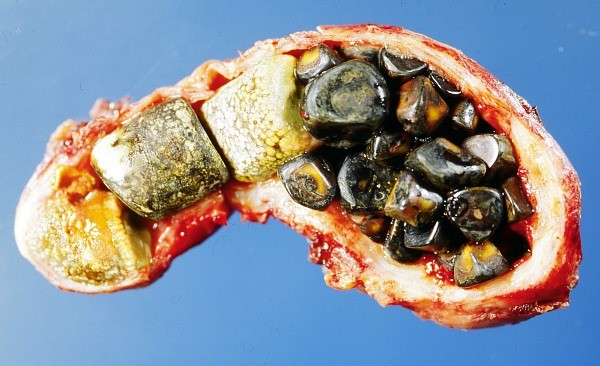
Many people do not experience symptoms from gallstones. They are usually discovered during examination for another health condition. However, some people experience an “attack” or pain that results from blockage of the bile ducts. The gallbladder is not essential, so the primary treatment is cholecystectomy, the removal of the gallbladder. Bile then flows directly from the liver into the small intestine.
References & Links
- Bar-Meir S. (2001) Gallstones: Prevalence, diagnosis and treatment. The Israel Medical Association Journal 3(2): 111.
- http://www.niddk.nih.gov/health-information/health-topics/digestive-diseases/gallstones/Pages/facts.aspx
- http://en.wikipedia.org/wiki/File:Gallstones.jpg
Video
Gallstones – http://www.youtube.com/watch?v=1q3NxfwSENM&feature=rec-HM-fresh+div
5.3 Irritable Bowel Syndrome
Up to 20% of Americans may have irritable bowel syndrome (IBS). A syndrome is a group of symptoms, not a disease. In IBS, the colon does not function correctly. The symptoms of IBS are cramping, bloating, gas, diarrhea, and/or constipation. The cause of IBS is unknown. Diet changes, stress reduction, and medicine may help manage the condition1. To learn more about IBS, see the reference below.
Reference
- http://www.niddk.nih.gov/health-information/health-topics/digestive-diseases/irritable-bowel-syndrome/pages/definition-facts.aspx
5.4 Inflammatory Bowel Disease
Inflammatory bowel disease (IBD) refers to a number of inflammatory conditions in the intestine. The two most common are Crohn’s Disease and ulcerative colitis. These two conditions differ mainly in the areas of the intestine that are affected. Crohn’s disease can occur anywhere throughout the GI tract, but most commonly occurs in the last part of the ileum. Crohn’s disease may also involve all layers of the intestine1. Ulcerative colitis are ulcers, or sores, in the lining of the colon and/or rectum2. It is estimated that up to 1 million people have IBD in the United States. Half of these individuals have Crohn’s disease, and the other half have ulcerative colitis3.
The figure in the link below illustrates the differences between these two conditions.
| Web Links |
The exact causes of these two diseases is not known. One hypothesized cause is an overactive immune system (autoimmune response, the immune system attack tissues/cells rather than pathogens) that results in the chronic inflammation and collateral damage to the cells of the intestine, resulting in formation of lesions.
Crohn’s disease and ulcerative colitis present symptoms similar to other gastrointestinal diseases, such as irritable bowel syndrome and GERD.
References & Links
- http://www.niddk.nih.gov/health-information/health-topics/digestive-diseases/crohns-disease/Pages/facts.aspx
2.http://www.niddk.nih.gov/health-information/health-topics/digestive-diseases/ulcerative-colitis/Pages/facts.aspx
- http://www.ccfa.org/info/about/crohns
Links
Ulcerative Colitis vs. Crohn’s Disease – http://www.quibd.com/wp-content/uploads/2015/08/DIFFERENCES001.jpg
5.5 Celiac Disease & Gluten
1 out of every 133 people in the United States has celiac disease1. People with celiac disease cannot consume the protein gluten because it causes their body to generate an autoimmune response (immune cells attack the body’s own cells) that causes damage to the villi in the intestine, as shown below.
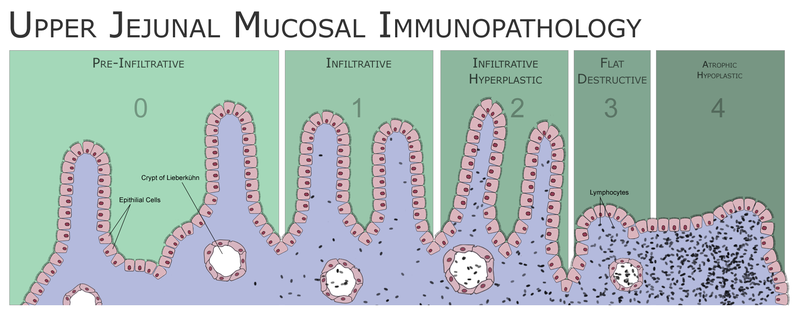
This damage to the villi impairs the absorption of macronutrients and micronutrients from food.
There are a variety of symptoms for celiac disease that vary depending on age and from person to person. For a listing of all symptoms, see the first link below. The second link describes the difficulty in diagnosing this disease, which is reinforced by the the third video link.
What is gluten?
Gluten is a protein that is bound to starch in the endosperm of grains such as:
Wheat
Barley
Rye
Triticale
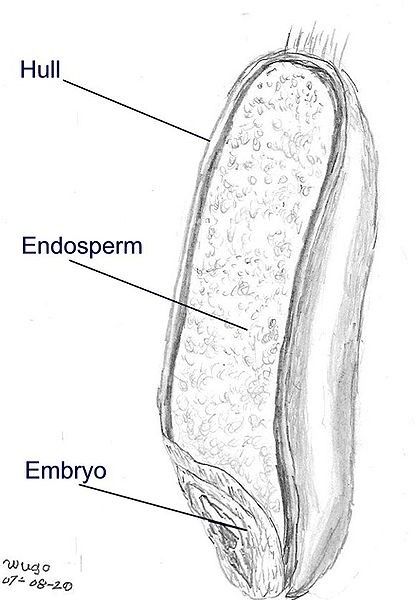
The video below does a nice job of providing some more information about this disease.
Gluten-free diets have been increasing in popularity even for people who don’t have celiac disease. The thinking among those consuming these diets is that they might be non-celiac gluten-sensitive, meaning that they experience adverse effects from consuming it. However, as the study describes, it seems more likely that it is fructan, a fructooligosaccharide, that causes these issues as found in the research described in the abstract below. These are apart of fermentable oligosaccharides-, disaccharides, monosaccharides and polyols (FODMAPs). Low FODMAP diets are increasing in use for similar reasons as gluten-free diets were used, but there is better evidence justification for their use.
| Web Link |
References & Links
- http://www.celiac.org/
- http://en.wikipedia.org/wiki/File:Coeliac_Disease.png
- http://en.wikipedia.org/wiki/File:Wheat_seed.jpg
Links
Fructan, Rather Than Gluten, Induces Symptoms in Patients With Self-Reported Non-Celiac Gluten Sensitivity https://www.ncbi.nlm.nih.gov/pubmed/29102613#
5.6 Diverticulosis and Diverticulitis
Approximately 10% of people under 40, and 50% of people over 60 years old have a condition known as diverticulosis1. In this condition, diverticula (plural, diverticulum singular), or outpouches, are formed at weak points in the large intestine, primarily in the lowest section of the sigmoid colon, as nicely shown in the figure below and in the video in the web link below.
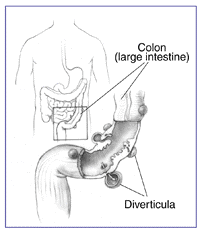
| Web Link |
It is believed that diverticula are formed as a result of a low-fiber diet because people may strain more during bowel movements. Most people with diverticulosis do not know that they have the condition. However, if the pouches become inflamed, then the condition is known as diverticulitis. The most common symptom of this condition is abdominal pain. A liquid diet may be needed until the inflammation is decreased, then fiber is gradually increased1.
References & Links
1.http://www.niddk.nih.gov/health-information/health-topics/digestive-diseases/diverticular-disease/Pages/facts.aspx#1
Video
5.7 Hemorrhoids
Hemorrhoids are swollen or inflamed veins of the anus or lower rectum. An internal hemorrhoid occurs within the anus, while an external hemorrhoid occurs in the skin surrounding the anus. Symptoms of hemorrhoids include bleeding, pain during bowel movements, and/or itching1. It is estimated that “about 75% of people will have hemorrhoids at some point in their lives”2.
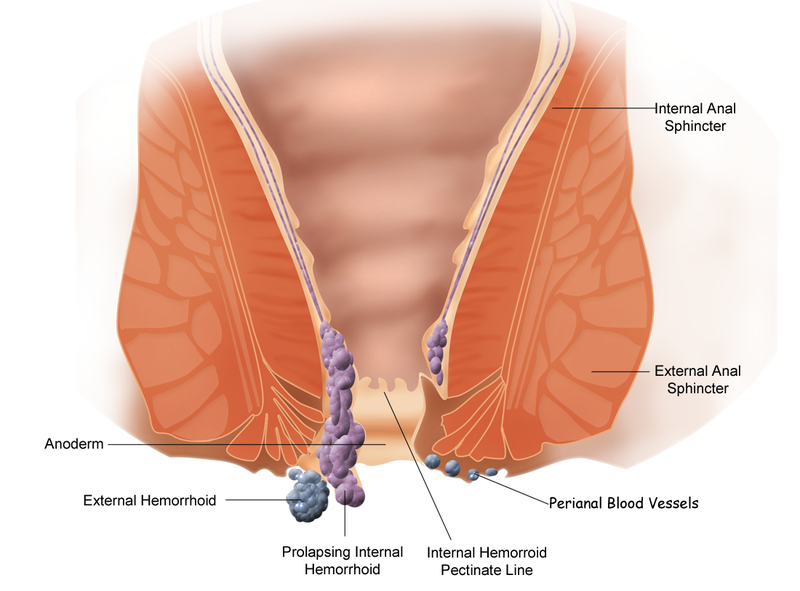
The first 55 seconds of the following video does a nice job of illustrating what hemorrhoids are and how they develop.
| Web Link |
The anus and lower rectum experience high pressure during bowel movements. Thus, hemorrhoids are believed to be caused by straining during bowel movements. To prevent this condition from occurring, it is recommended that people consume a high-fiber diet, drink plenty of water, and exercise to produce regular, large, soft stools. In addition, people should “go” at first urge and not wait until it is more than an urge2.
References & Links
- http://www.webmd.com/a-to-z-guides/hemorrhoids-topic-overview
- http://www.niddk.nih.gov/health-information/health-topics/digestive-diseases/hemorrhoids/Pages/facts.aspx
- http://en.wikipedia.org/wiki/File:Hemorrhoid.png
Video
Hemorrhoids – http://www.youtube.com/watch?v=C8vZoIhQCwU

